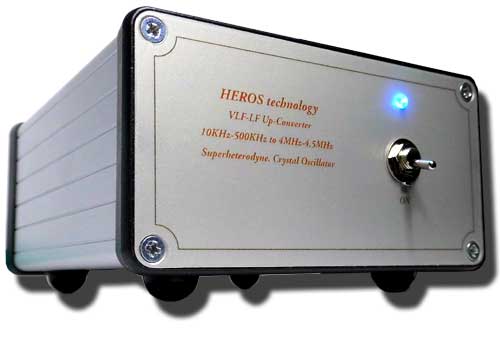Many thanks to SWLing Post reader, Michael Vitale, who (several weeks ago–!) asked:
Has anyone ever dealt with the equipment from Heros Technology Ltd UK specifically their VLF converters models 350-400? Their claim is these converters will work with any receiver (SW) on the market past or present.
Click here to view the video introduction to the VLF-LF Up-Converter.
I, personally, have no experience with VLF/LF up-converters, so I’m hoping someone else can help Michael. Please comment!


Just finished a review of the Heros VLF
Converter.
As far as sensitivity goes it’s no better
than a Palomar.
The extra shielding and circuitry might be
of use in a dense RF environment like
London but its advantages were not noticed-or
needed-here.
There is a Heros vlf converter on the ham radio outlet website.
Heros Technology VLF-LF-MF Up-Converter
https://www.herostechnology.co.uk/pages/VLF-LF-MF_Up-Converter.html#LFPICT
Specifications:
– Compatible with any kind of radios analogue (valves, semiconductors) or digital (Software Define Radio).
– Converter class: Superheterodyne. IF output mirrored up.
– Type: Double balanced mixer; Quartz crystal oscillator.
– Frequency range: 80dB
– Crystal oscillator: Low phase noise; quartz crystal ±5ppm;
3.5MHz or 4MHz, fundamental.
– Power: 12volts/40mA
– Enclosure: Aluminium
– Size: 125mmx105mx55mm ( 4.921×4.133×2.165in)
There can’t be much variation between them. A mixer and crystal oscillator, how low it goes would generally depend on how balanced the mixer is (so there’s less feed through of the crystal oscillator) and how shielded the oscillator is. Since “0” is at the crystal frequency, the weaker it is the closer to that frequency you can receive signals. Though way down there, you’ll need a good antenna.
Early projects just used a single transistor as the mixer and oscillator, giving up the notion of the very lowest frequences.
Generally there’s just a low pass filter between the antenna and the rest of the converter. No tuning needed, it does mean the converter has to handle any large signals that are below the low pass filter’s cut-off frequency. Setting it lower means fewer signals, but you lose tuning range. Set it so you can tune the broadcast band, and you’re stuck with any strong local AM signals.
A preselector could be used, but then you’d need a big variable capacitor and lots of coils (increasingly large). Since a 2:1 tuning range is about the norm, the lower you go the more coils you need, and the narrower the spectrum segment tuned with that coil. But a preselector mean the converter will see fewer signals at ä time. One could add a preselector to any vlf onverter.
The mixer will determine how easily the converter overloads. A gain device is more likely to overload, though some mixer types are better than others. A diode mixer is especially overload resistant, but it gives a loss.
Amplification is often added to make up for short antennas, but means the mixer will see stronger signals, and thus overload sooner. Since the amplification is broadband, signals you aren’t listening to could affect operation.
There have been lots of vlf converters described in hobby magazines, often simple and cheap, but some are intended for better operation.
Michael
I appreciate all the feedback,however the cost is a little high. I have heard good reviews concerning northcountryradio.com, their units are offered in kit or completed form. I believe I will be ordering from them. Thanks Mike V for
A VLF converter simply takes Longwave 0-500 khz and up converts it to HF,
usually 4-4.5 mhz.
Sometimes other ranges like 3.5-4 (80 meters) or even 10 meters (28-30)
are used.
Most receivers that do cover VLF aren’t too hot there so these come in handy.
In my experience this is the best of the bunch:
http://hamcrafters2.com/VLF.html
Hopefully Art still sells them…it is an updated version of the famous Palomar
converter;Art bought the rights in 2010.
There is a battery conversion for 9 volt operation,email me if you wish to do it.
These converters pop up on ebay from time to time,too.
Do not mess with the Heathkit converter.They are insensitive (even have a
built in preamp,still not enough).
You can run one of these ahead of a portable with great success;I got all 5 LWBC
stations in europe with one ahead of a KA-1103 with a homebrew loop.
Just heard from Art at Hamcrafters…they no longer make this converter.
So if you want one keep an eye on ebay.
A word about Jack Allbriton’s original Palomar converters:
The very first ones were in a small red or white or orange minibox
with coax connectors at each end.Due to their forty-plus year age
they should be avoided.
The ones in the cabinent with connectors on the back (and a 9v
battery holder) with an on/off switch with a pointer are the next
oldest.
Late model original Palomars have the same round knob as Art’s
but with th 9v battery holder on the back.
These are OK,along with Art’s in the reply above.
Thanks for the update and research, Ron!
-Thomas
If you don’t mind soldering and providing your own switch,
connectors,minibox and so forth here is Chuck Olsen’s 14 buck
vlf converter.
Expect performance on a par with the Heathkit converter
but it is 14 bucks- and it works as advertised:
http://www.wb9kzy.com/lfconv.htm
Heros Technology VLF-LF-MF bands Up-Converter
Specifications:
– Compatible with any kind of radios analogue (valves, semiconductors) or digital (Software Define Radio).
– Converter class: Superheterodyne. IF output mirrored up.
– Type: Double balanced mixer; Quartz crystal oscillator.
– Frequency range: 80dB
– Crystal oscillator: Low phase noise; quartz crystal ±5ppm;
3.5MHz or 4MHz, fundamental.
– Power: 12volts/40mA
– Enclosure: Aluminium
– Size: 125mmx105mx55mm ( 4.921×4.133×2.165in)